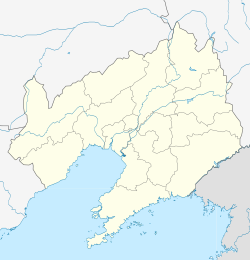Dandong Langtou Airport 丹东浪头机场 | |||||||||||
|---|---|---|---|---|---|---|---|---|---|---|---|
 Airport main building exterior | |||||||||||
| Summary | |||||||||||
| Airport type | Public | ||||||||||
| Operator | Civil Aviation Administration of China | ||||||||||
| Serves | Dandong, Liaoning | ||||||||||
| Location | Tangchi, Zhenxing District, Dandong, Liaoning | ||||||||||
| Opened | 21 December 1985 | ||||||||||
| Elevation AMSL | 9.1 m / 30 ft | ||||||||||
| Coordinates | 40°01′33″N124°17′13″E / 40.025951°N 124.286906°E | ||||||||||
| Website | www | ||||||||||
| Map | |||||||||||
 | |||||||||||
| Runways | |||||||||||
| |||||||||||
| Statistics (2021) | |||||||||||
| |||||||||||
| Dandong Langtou Airport | |||||||
|---|---|---|---|---|---|---|---|
| Simplified Chinese | 丹东 浪 头 机场 | ||||||
| Traditional Chinese | 丹東浪頭機場 | ||||||
| |||||||
Dandong Langtou Airport( IATA :DDG, ICAO :ZYDD) is an airport serving the city of Dandong,Liaoning,China.

